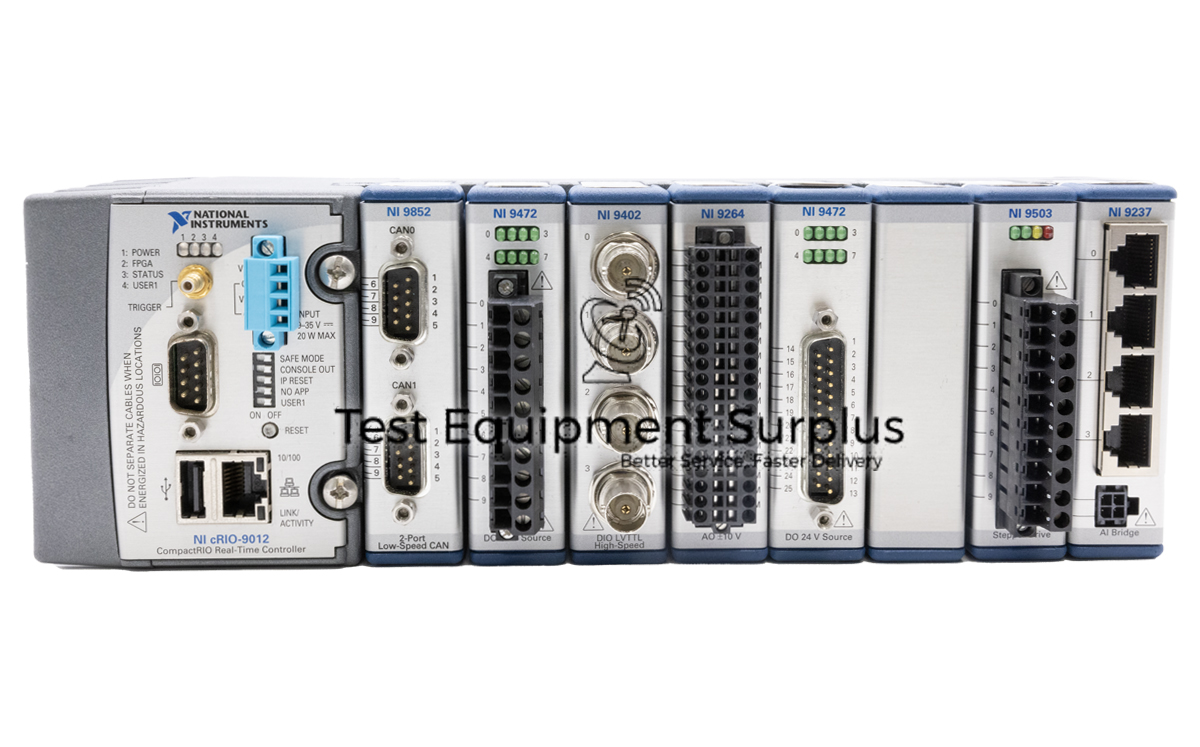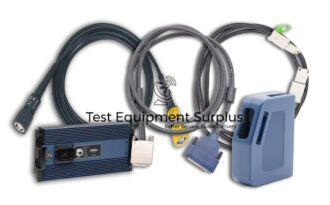Description
The National Instruments cRIO-9002 CompactRIO Real-Time Controller, with Part Number 779000-01, is a high-performance controller featuring a 195 MHz CPU, 32 MB DRAM, and 64 MB of nonvolatile flash storage.
It offers a range of interfaces including LEDs, a power connector, DIP switches, a reset button, an RJ-45 port, and an RS-232 port, supporting various operational modes like Safe Mode, Console Out, IP Reset, No App, and User1.
The robust controller boasts an impressive Mean Time Between Failures (MTBF) of 1,253,788 hours at 25°C and is capable of operating within a temperature range of -40°C to 70°C, with a storage temperature range of -40°C to 85°C.
Its network interfaces are compatible with 10Base-T and 100Base-TX Ethernet, adhering to the IEEE 802.3 standard, and provide communication rates of 10 Mbps and 100 Mbps with auto-negotiation.
Supporting various software platforms, this controller is compatible with NI-RIO driver, ETS OS, LabVIEW and its modules, including the LabVIEW FPGA and LabVIEW Real-Time Modules, as well as the LabVIEW Professional Development System.
The device is lightweight, tipping the scales at just 17.2 oz, making it suitable for a variety of industrial applications where durability and reliability are paramount.
| Specification | Detail |
|---|---|
| Part Number | 779000-01 |
| Product Line | National Instruments cRIO-9002 CompactRIO Real-Time Controller |
| CPU Speed | 195 MHz |
| DRAM | 32 MB |
| Storage | 64 MB nonvolatile flash |
| Interfaces | LEDs, Power Connector, DIP Switches, Reset Button, RJ-45 Port, RS-232 Port |
| Operational Modes | Safe Mode, Console Out, IP Reset, No App, User1 |
| MTBF | 1,253,788 hours at 25°C |
| Network Interface | 10Base-T and 100Base-TX Ethernet, IEEE 802.3 |
| Communication Rates | 10 Mbps and 100 Mbps, Auto-Negotiation |
| Software Compatibility | NI-RIO driver, ETS OS, LabVIEW, LabVIEW FPGA Module, LabVIEW Real-Time Module, LabVIEW Professional Development System |
| Weight | 17.2 oz |
| Operating Temperature Range | -40°C to 70°C |
| Storage Temperature Range | -40°C to 85°C |
Question 1: What is the operating temperature range of the National Instruments cRIO-9002 CompactRIO Real-Time Controller with Part Number 779000-01?
Answer 1: The DIP switches on the National Instruments cRIO-9002 CompactRIO Real-Time Controller are used to configure the device’s operating modes, such as Safe Mode, Console Out, IP Reset, No App, and User1, allowing users to customize the controller’s behavior for specific application needs.
Question 2: What is the storage temperature range capability of the National Instruments cRIO-9002 CompactRIO Real-Time Controller with Part Number 779000-01?
Answer 2: The storage temperature range capability of the National Instruments cRIO-9002 CompactRIO Real-Time Controller with Part Number 779000-01 is from -40°C to 85°C.
Question 3: What is the function of the DIP switches on the National Instruments cRIO-9002 CompactRIO Real-Time Controller?
Answer 3: The operating temperature range of the National Instruments cRIO-9002 CompactRIO Real-Time Controller with Part Number 779000-01 is from -40°C to 70°C.
Question 4: What are the memory specifications and operational temperature ranges of the National Instruments cRIO-9002 CompactRIO Real-Time Controller with Part Number 779000-01?
Answer 4: The National Instruments cRIO-9002 CompactRIO Real-Time Controller with Part Number 779000-01 features 32 MB DRAM and 64 MB of nonvolatile flash storage, and it can operate within a temperature range of -40°C to 70°C, with a storage temperature range of -40°C to 85°C.
Question 5: How does the National Instruments cRIO-9002 CompactRIO Real-Time Controller ensure robust and reliable performance in industrial applications?
Answer 5: The National Instruments cRIO-9002 CompactRIO Real-Time Controller ensures robust and reliable performance in industrial applications through its high Mean Time Between Failures (MTBF) of 1,253,788 hours at 25°C, a durable operating temperature range of -40°C to 70°C, compatibility with various software platforms including NI-RIO driver and LabVIEW modules, and a range of interfaces to support multiple operational modes, all packaged in a lightweight yet sturdy design.



